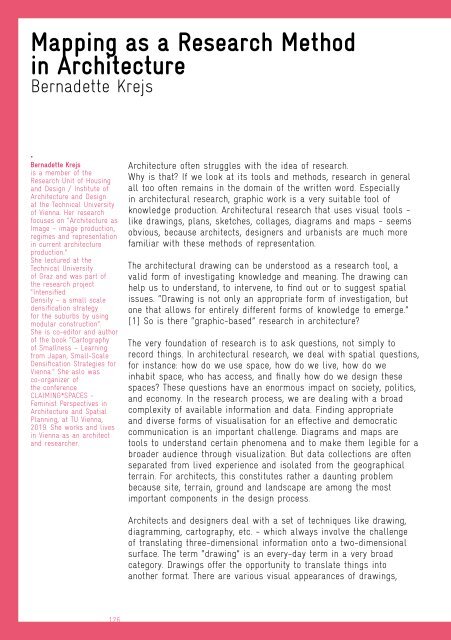Mapping the Croatian Coast
ISBN 978-3-86859-648-9
ISBN 978-3-86859-648-9
Create successful ePaper yourself
Turn your PDF publications into a flip-book with our unique Google optimized e-Paper software.
<strong>Mapping</strong> as a Research Method<br />
in Architecture<br />
Bernadette Krejs<br />
•<br />
Bernadette Krejs<br />
is a member of <strong>the</strong><br />
Research Unit of Housing<br />
and Design / Institute of<br />
Architecture and Design<br />
at <strong>the</strong> Technical University<br />
of Vienna. Her research<br />
focuses on “Architecture as<br />
Image – image production,<br />
regimes and representation<br />
in current architecture<br />
production.”<br />
She lectured at <strong>the</strong><br />
Technical University<br />
of Graz and was part of<br />
<strong>the</strong> research project<br />
“Intensified<br />
Density – a small scale<br />
densification strategy<br />
for <strong>the</strong> suburbs by using<br />
modular construction”.<br />
She is co-editor and author<br />
of <strong>the</strong> book “Cartography<br />
of Smallness – Learning<br />
from Japan, Small-Scale<br />
Densification Strategies for<br />
Vienna.” She aslo was<br />
co-organizer of<br />
<strong>the</strong> conference<br />
CLAIMING*SPACES -<br />
Feminist Perspectives in<br />
Architecture and Spatial<br />
Planning, at TU Vienna,<br />
2019. She works and lives<br />
in Vienna as an architect<br />
and researcher.<br />
Architecture often struggles with <strong>the</strong> idea of research.<br />
Why is that? If we look at its tools and methods, research in general<br />
all too often remains in <strong>the</strong> domain of <strong>the</strong> written word. Especially<br />
in architectural research, graphic work is a very suitable tool of<br />
knowledge production. Architectural research that uses visual tools -<br />
like drawings, plans, sketches, collages, diagrams and maps - seems<br />
obvious, because architects, designers and urbanists are much more<br />
familiar with <strong>the</strong>se methods of representation.<br />
The architectural drawing can be understood as a research tool, a<br />
valid form of investigating knowledge and meaning. The drawing can<br />
help us to understand, to intervene, to find out or to suggest spatial<br />
issues. “Drawing is not only an appropriate form of investigation, but<br />
one that allows for entirely different forms of knowledge to emerge.”<br />
[1] So is <strong>the</strong>re “graphic-based” research in architecture?<br />
The very foundation of research is to ask questions, not simply to<br />
record things. In architectural research, we deal with spatial questions,<br />
for instance: how do we use space, how do we live, how do we<br />
inhabit space, who has access, and finally how do we design <strong>the</strong>se<br />
spaces? These questions have an enormous impact on society, politics,<br />
and economy. In <strong>the</strong> research process, we are dealing with a broad<br />
complexity of available information and data. Finding appropriate<br />
and diverse forms of visualisation for an effective and democratic<br />
communication is an important challenge. Diagrams and maps are<br />
tools to understand certain phenomena and to make <strong>the</strong>m legible for a<br />
broader audience through visualization. But data collections are often<br />
separated from lived experience and isolated from <strong>the</strong> geographical<br />
terrain. For architects, this constitutes ra<strong>the</strong>r a daunting problem<br />
because site, terrain, ground and landscape are among <strong>the</strong> most<br />
important components in <strong>the</strong> design process.<br />
Architects and designers deal with a set of techniques like drawing,<br />
diagramming, cartography, etc. - which always involve <strong>the</strong> challenge<br />
of translating three-dimensional information onto a two-dimensional<br />
surface. The term “drawing” is an every-day term in a very broad<br />
category. Drawings offer <strong>the</strong> opportunity to translate things into<br />
ano<strong>the</strong>r format. There are various visual appearances of drawings,<br />
126


















